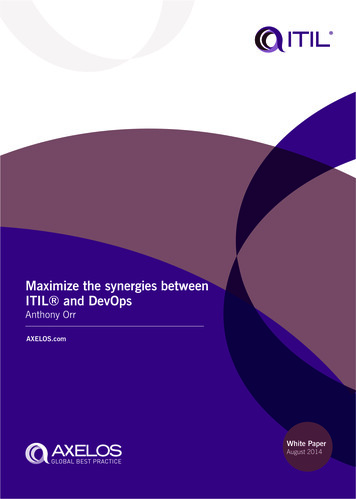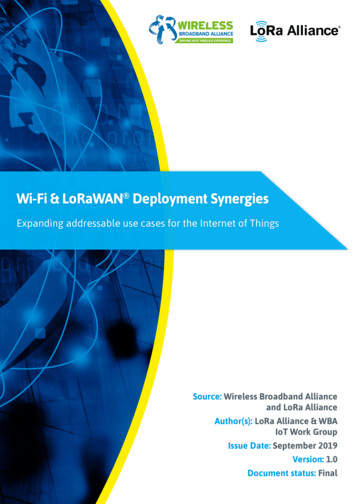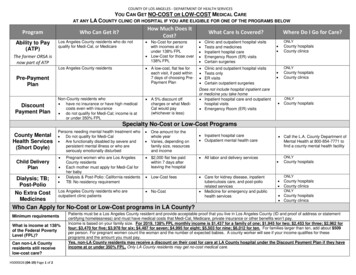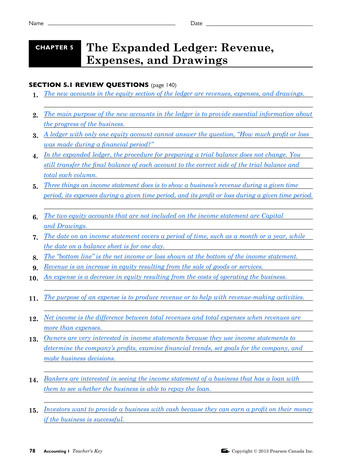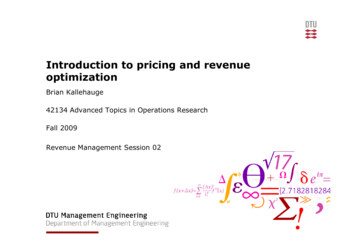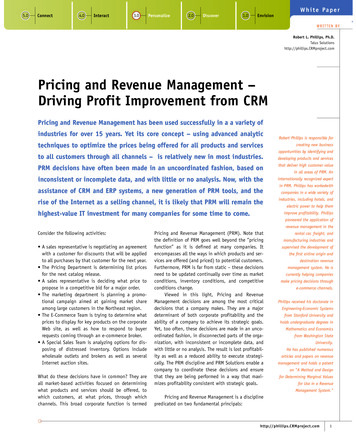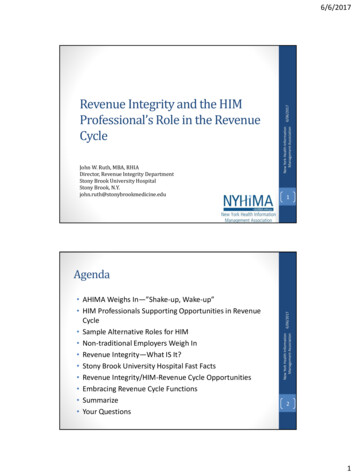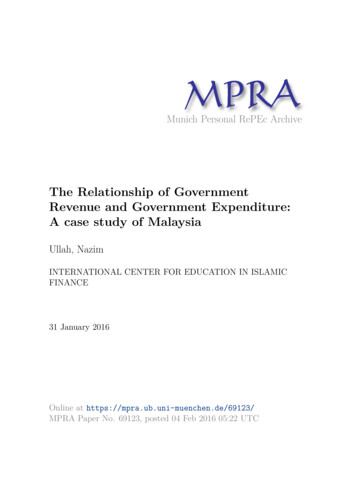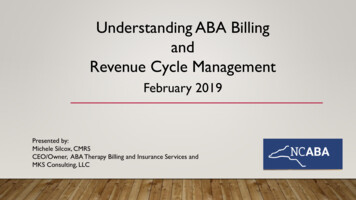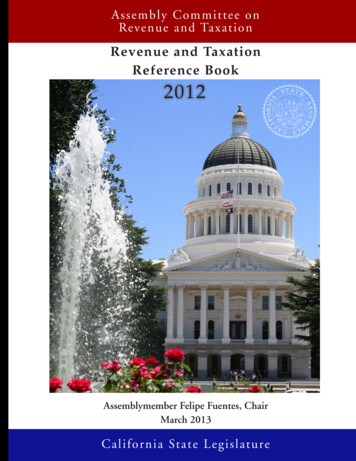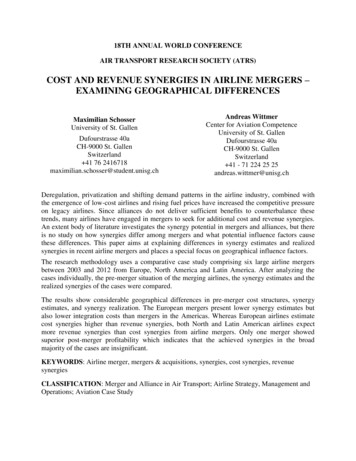
Transcription
18TH ANNUAL WORLD CONFERENCEAIR TRANSPORT RESEARCH SOCIETY (ATRS)COST AND REVENUE SYNERGIES IN AIRLINE MERGERS –EXAMINING GEOGRAPHICAL DIFFERENCESMaximilian SchosserUniversity of St. GallenDufourstrasse 40aCH-9000 St. GallenSwitzerland 41 76 2416718maximilian.schosser@student.unisg.chAndreas WittmerCenter for Aviation CompetenceUniversity of St. GallenDufourstrasse 40aCH-9000 St. GallenSwitzerland 41 - 71 224 25 25andreas.wittmer@unisg.chDeregulation, privatization and shifting demand patterns in the airline industry, combined withthe emergence of low-cost airlines and rising fuel prices have increased the competitive pressureon legacy airlines. Since alliances do not deliver sufficient benefits to counterbalance thesetrends, many airlines have engaged in mergers to seek for additional cost and revenue synergies.An extent body of literature investigates the synergy potential in mergers and alliances, but thereis no study on how synergies differ among mergers and what potential influence factors causethese differences. This paper aims at explaining differences in synergy estimates and realizedsynergies in recent airline mergers and places a special focus on geographical influence factors.The research methodology uses a comparative case study comprising six large airline mergersbetween 2003 and 2012 from Europe, North America and Latin America. After analyzing thecases individually, the pre-merger situation of the merging airlines, the synergy estimates and therealized synergies of the cases were compared.The results show considerable geographical differences in pre-merger cost structures, synergyestimates, and synergy realization. The European mergers present lower synergy estimates butalso lower integration costs than mergers in the Americas. Whereas European airlines estimatecost synergies higher than revenue synergies, both North and Latin American airlines expectmore revenue synergies than cost synergies from airline mergers. Only one merger showedsuperior post-merger profitability which indicates that the achieved synergies in the broadmajority of the cases are insignificant.KEYWORDS: Airline merger, mergers & acquisitions, synergies, cost synergies, revenuesynergiesCLASSIFICATION: Merger and Alliance in Air Transport; Airline Strategy, Management andOperations; Aviation Case Study
Schosser, Wittmer: Cost and Revenue Synergies in Airline Mergers11IntroductionIn the past 15 years, the global airline industry has undergone major changes. Deregulation,privatization and shifting demand patterns led to a significant change in the business environment(Sterzenbach, Conrady, & Fichert, 2013). The price pressure increased due to emerging low-costcarriers and rising fuel prices. As a result, many airlines faced declining profitability and had torethink their business models as independent full-service carriers (Iatrou & Oretti, 2007).Synergies became a major issue in order to respond to the increasing price pressure. In thebeginning, most airlines strived for airline alliances to create cost and revenue synergies that ledto the formation of big airline alliances, such as Star Alliance, oneworld and SkyTeam. In 2010,these three alliances accounted for a total share of 68% of total revenue passenger-kilometers(RPKs) flown, with an increasing tendency (IATA, 2011).However, alliance synergies seem to be insufficient to maintain competitiveness as the increasedmergers & acquisitions (M&A) activity among airlines in the past 10 years signals. The mostrecent M&A wave started in 2001 with the TWA takeover by American Airlines. This transactionset off a domestic consolidation wave in the United States (US) and paved the way forsubsequent further large mergers. With the most recently announced merger between AmericanAirlines and US Airways, only three large legacy carriers dominate the market in the UnitedStates, namely American Airlines, Delta Airlines and United Airlines. In Europe, a similarconsolidation wave formed three large legacy airlines: Air France-KLM, the InternationalAirlines Group (IAG), and the Lufthansa Group. The cross-border airline merger phenomenonhas even arrived in emerging markets like Latin America, producing the LATAM Group and theAviancaTACA Group.Most literature compares cost and revenue synergies in airline alliances to synergies emergingfrom M&A in order to explain the current M&A wave (e.g. Doganis, 2010; Iatrou & Oretti, 2007;Kleymann & Seristö, 2004). However, there are no studies on how cost and revenue synergiesdiffer among airline mergers and what potential influence factors could explain these differences.Furthermore, the actual achievement of synergies in airline mergers has not yet been analyzed inscholarly literature.This paper aims at explicating differences in airline merger synergy estimates and realizedsynergies in recent airline mergers. Special focus is placed on three influence factors, namely thegeographic origin of the merging airlines, the maturity of their home market and whether themerger is a domestic merger or a cross-border merger. This aim is concisely addressed in twoguiding research questions:
Schosser, Wittmer: Cost and Revenue Synergies in Airline Mergers2RQ-1: How do cost and synergy estimates differ between different mergers?RQ-2: How have the estimated synergies been realized? Which estimated synergies wererealized and which synergies could not be realized?The second chapter presents the literature review followed by chapter 3 research explaining theapproach. Chapter 4 presents the case study results which are discussed and interpreted in chapter5 and concluded upon in chapter 6.2Synergies in airline mergersThe existence of cost synergies (Appendix 1) in airline cooperations has been widelyacknowledged in the literature (Evripidou, 2012; Götsch & Albers, 2005; Hansson, Neilson, &Belin, 2001; Merkert & Morrell, 2012; Rajasekar & Fouts, 2009). However, the classification ofpotential cost synergies varies widely between scholars. Table 1 summarizes the main costsynergy sources and the respective levers.Most cost synergies arise because of redundancies of processes, resources or assets asconsequence of the cooperation. Eliminating these redundancies is a major driver for efficiencyenhancements in both mergers and acquisitions. A second common lever is joint procurement offuel, materials and IT systems. Thanks to a greater bargaining power, companies can benefit fromlower fees, sales commissions and financing costs (e.g., for aircraft leases). Furthermore, fleetstandardization can positively impact maintenance and training costs, and network and flightschedule optimization can result in better aircraft utilization, creating economies of density andlowering the variable operating costs.
Schosser, Wittmer: Cost and Revenue Synergies in Airline MergersTable 1:3Cost synergy classification for airlinesCost synergyLabor costsNetwork optimizationFuel & MaterialsCost lever Elimination ofredundancies Elimination or reductionof inefficient hubs androutes Higher aircraft utilization Reducing redundantcapacity Higher bargaining powerthrough joint procurementSource(Evripidou, 2012; Merkert &Morrell, 2012)(Caves, Christensen, &Tretheway, 1984; Evripidou,2012; Hansson et al., 2001;Merkert & Morrell, 2012)(Evripidou, 2012; Götsch &Albers, 2005; Hansson et al.,2001; Merkert & Morrell,2012)(Hansson et al., 2001;Merkert & Morrell, 2012)Maintenance & Training Fleet standardizationInfrastructure Joint infrastructure Reduction of redundantinfrastructure(Götsch & Albers, 2005;Hansson et al., 2001)Fees (Landing, groundhandling, overflight) Bargaining power(Hansson et al., 2001) Sales and MarketingIT systemsLower financing & capitalcosts Elimination of duplicatesales functionsRationalization ofcorporate volumeagreements andcommissionsDevelopment of joint ITsystemsIncrease of credit ratingLower leasing fees(Hansson et al., 2001;Merkert & Morrell, 2012;Rajasekar & Fouts, 2009)(Merkert & Morrell, 2012)(Götsch & Albers, 2005)Similar to cost synergies, revenue synergies are also widely accepted as profitability drivers inairline cooperations (Fritz, 2005; Götsch & Albers, 2005; Hansson et al., 2001; Merkert &Morrell, 2012; Rajasekar & Fouts, 2009). The nature of revenue synergies lies in creating superadditive value with an unchanged set of production factors. However, the combination ofproduction factors allows for an increase in price or passenger volume.
Schosser, Wittmer: Cost and Revenue Synergies in Airline MergersTable 2:4Revenue synergy classification for airlinesRevenue synergyRevenue lever Access to new markets (slots, traffic rights)More flights possibleLess regulatoryrestrictions Higher customerattractivenessCombination of frequentflyer programs Higher customerattractivenessHarmonized pricing Higher marginsIncreased market power Higher margins Better fulfillment ofcustomer needsLarger networkJoint market analysisSource(Götsch & Albers, 2005;Hansson et al., 2001; Merkert& Morrell, 2012; Rajasekar& Fouts, 2009)(Fritz, 2005; Götsch &Albers, 2005; Hansson et al.,2001; Rajasekar & Fouts,2009)(Götsch & Albers, 2005;Hansson et al., 2001;Rajasekar & Fouts, 2009)(Fritz, 2005; Götsch &Albers, 2005; Merkert &Morrell, 2012)(Götsch & Albers, 2005;Merkert & Morrell, 2012)(Götsch & Albers, 2005)Synergies can be achieved in all forms of cooperations between airlines. However, the amount ofsynergies as well as the type of achievable synergies seems to be related to the level ofintegration. In other words, airlines can realize a different amount of synergies in alliances than inmergers. This fact is confirmed by various scholars (e.g. Gudmundsson & Lechner, 2006; Iatrou& Alamdari, 2005; Iatrou & Oretti, 2007; Merkert & Morrell, 2012). Nevertheless, the precisedifferences remain unclear.Most scholars assume that airline mergers (Appendix 1) allow for more overall synergies thanairline alliances. Flores (1998) classifies alliances as “soft solution” to capture synergies withoutrisking the merger risks whereas Iatrou & Alamdari (2005) see alliances as the only viable optionfor realizing synergies when stringent regulatory frameworks are in place. In the same spirit, Fritz(2005) sees alliances as a door-opener for M&A transactions since ongoing cooperation lowersthe transaction costs of merging and improves the quality of due-diligence because of jointexperience and some joint operations.This claim is nevertheless disputed in literature. For instance, Gudmundsson & Lechner (2011)argue that merger benefits are only larger when the merger partners have not been engaged in thesame alliance before. In a previous theoretical study (2006), these authors also claim thatalliances generate primarily revenue synergies while M&A also create cost synergies. This claimis supported empirically by several studies of Iatrou & Oretti who used executive surveys to learn
Schosser, Wittmer: Cost and Revenue Synergies in Airline Mergers5about the performance implication of airlines alliances. In an empirical study of 2005, topexecutives acknowledged witnessing revenue increases and cost reductions (80% of respondentsclaimed so) as consequence of joining an alliance. However, most executives did not value thecost reductions as significant as the revenue increases and the impact of alliances was deemedhigher for developing countries compared to developed countries. In a follow-up study, Iatrou &Oretti (2007) find that executives expect alliances to deliver more synergies than mergers only inthe “market growth” factor. In the categories “Economies of scope” and “Efficient use of hubs”,there are no significant differences between mergers and alliances. In all other categories,including economies of scale, procurement, network optimization and lower financing costs, thepositive effects of mergers are significantly higher than the positive effects of alliances. However,the risk of negative synergies is also estimated to be much higher in mergers than in alliances.Merkert & Morrell (2012) confirm the perception of airline executives as they find evidencesuggesting that if M&A partners were part of the same alliance, most synergies are cost-synergiesas most revenue-synergies have already been captured through the common strategic alliance.In conclusion, mergers seem to allow for higher positive synergies than alliances. Revenuesynergies can be realized in both mergers and alliances whereas cost synergies are easier tocapture in mergers. The merger synergy potential is hence lower for airlines which are alreadyengaged in the same alliance before.3Research approachDue to the novelty of the cross-border merger phenomenon in the airline industry, only fewexamples of this kind of merger exist so far. The small sample complicates a purely empiricalresearch method and calls for alternative approaches. The comparative case study methodologydeveloped by Eisenhardt (1989) and refined by Yin (2013) offers an attractive alternative thatcombines qualitative research with empirical elements. Eisenhardt (1989) recommends using itespecially for “early stages of research on a topic” which definitively applies to cross-borderairline mergers. The case method has already been used by various air transport scholars (e.g.,Graf, 2005; Lawton, Rajwani, & O’Kane, 2011) and is thus well-established in the field ofaviation. Hence, this paper follows a mainly qualitative research design inspired by thecomparative case study method.3.1Literature reviewFirst, a literature review is conducted following a structured keyword-based approach which wasdeveloped by Webster & Watson (2002) and adapted by Vom Brocke et al. (2009). The
6Schosser, Wittmer: Cost and Revenue Synergies in Airline Mergersmethodology comprises two main processes, literature search and literature evaluation, which areconducted in parallel and iteratively.The first process step starts with the identification of relevant journals and databases for theliterature search, while the se
Schosser, Wittmer: Cost and Revenue Synergies in Airline Mergers 1 1 Introduction In the past 15 years, the global airline industry has undergone major changes. Deregulation, privatization and shifting demand patterns led to a significant change in the business environment (Sterzenbach, Conrady, & Fichert, 2013). The price pressure increased due to emerging low-cost
